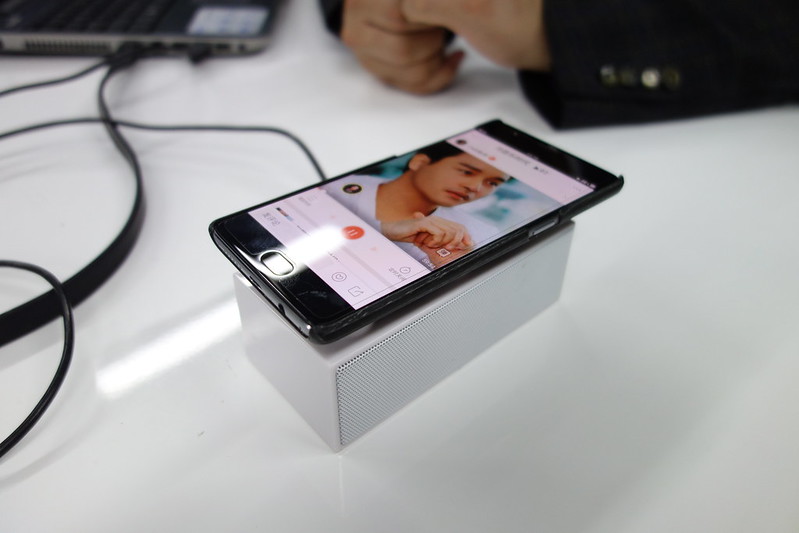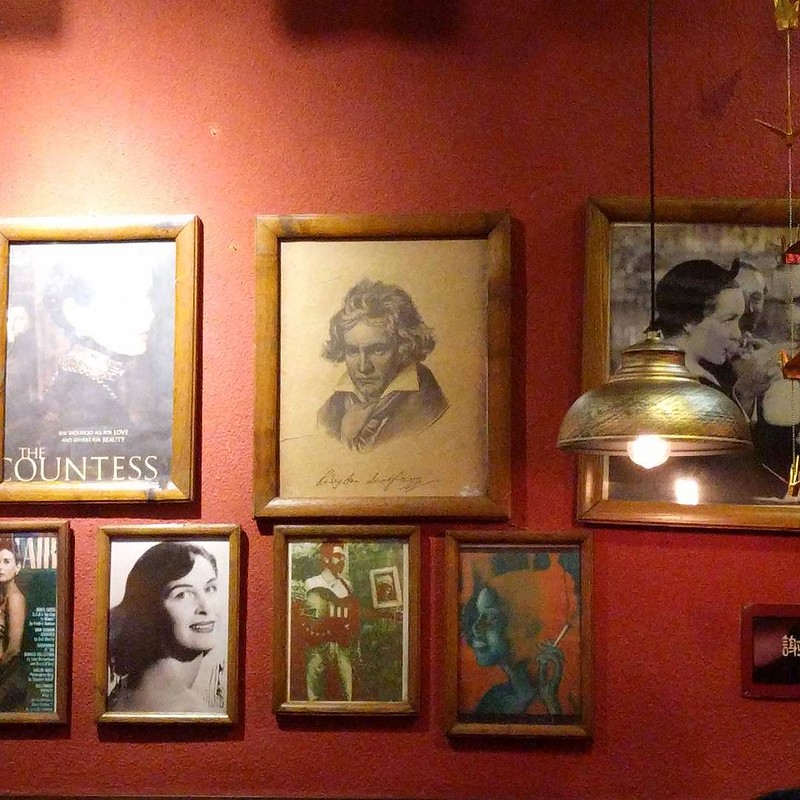This and the following blog posts aims to document a trip to Shenzhen, to the cradle of things. To read all blog posts in the series, click on the viewsource tag.
Please note: These are quick notes typed up while traveling. Apologies for any typos, missing links, etc.
Shopping for 2016 ThingsCon lanyards in Shenzhen from ThingsConAMS on Vimeo.
A video of us shopping for ThingsCon lanyards.
///
It’s the last full day with the whole team. Today’s plan: Visit HAX, visit World Maker Group. Record our reflections on the week in Shenzhen.
///
Headed to HAX, we struggle: Navigating the city still is tricky. We get totally lost inside an office building. Then in another. Turns out that a) HAX had moved and b) our Chinese navigation skills are more than sub-prime.
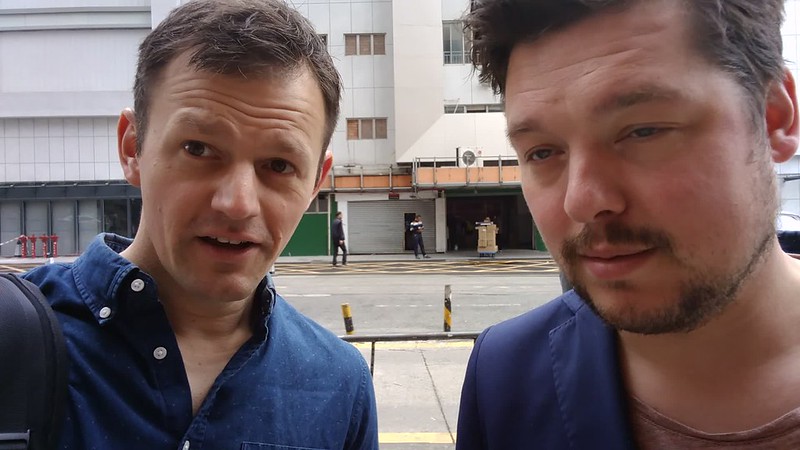 We tried Google Translate on our Chinese address: It translated it to “cold sore feet”.
We tried Google Translate on our Chinese address: It translated it to “cold sore feet”.
HAX is the first and largest hardware accelerator, and a known, well-respected player in the field. Design director Noel Joyce kindly shows us around.
Some quick notes about HAX:
- Within 4 years from 10 teams/year to 50 teams/year
- Around 150 teams so far
- 2-step offering: first accelerator in Shenzhen to build the product, then “booster” in SF to get it to market.
- Areas: Life, health, robotics, infrastructur, fab
It looks like a great place & community. Lots of energy, ambitious plans and projects, tapped into the local ecosystem. You can tell the benefits of being able to pick from a huge pool of applicants: The projects we see are all top notch.
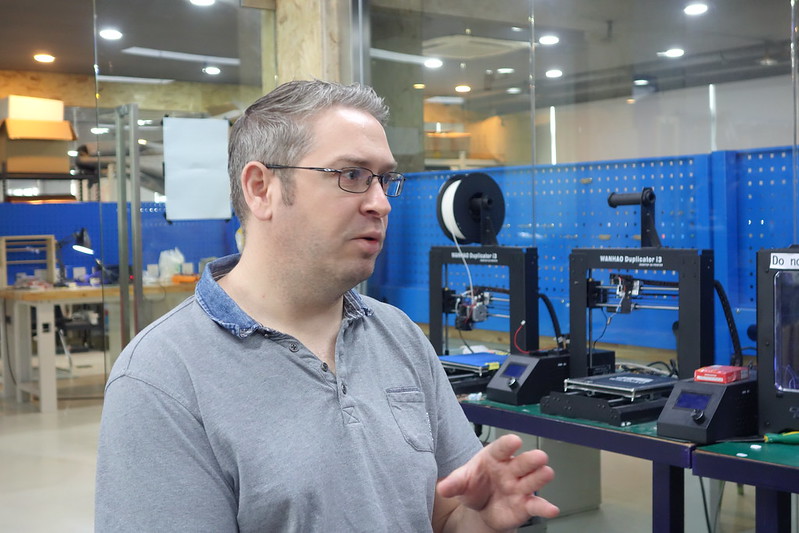 Noel Joyce, HAX’s design director
Noel Joyce, HAX’s design director
“A week here is like a month elsewhere”
Noel shares some of his insights about Shenzhen (some of my own notes mixed in):
- Speed & access to supply chain is priceless. From CAD in the morning to finished model the next day at the very latest.
- It’s possible and highly recommended to tap into the local knowledge. Folks here know how to build things highly efficiently and cost-effectively, know how to reverse engineer, know how to improve them.
- Noel: “Some see Shanzhai as a problem. We don’t see it as a problem” (and rather as a great talent pool and skill set).
- “The advantages of this place far outweigh the weaknesses it might have.”
- It’s important to learn about sourcing and how to build a supply chain.
- “A week here is like a month elsewhere.”
- Different storytelling approaches between Chinese and international teams. HAX puts Chinese and international teams on different schedules, especially using more time with local teams on storytelling and branding. (Note: We heard this echoed many times during our time in China.) Also, Chinese teams are often very engineering driven.
- “What you see in this market shows where the global market is shifting.”
- It’s a challenge to anticipate the tech pipeline, like which chipsets are going to be available a few months from now. Some things are only made for a month and might never come back. HAX has a person whose primary job it is to be tapped into these conversations and anticipate availability, which products and compontents to use to be as futureproof as possible.
- Question I ask myself: What are the limits of openness? Where do people draw the line? It seems like (unlike many places in the West) openness is the default, but there seem to be exceptions.
“It’s a challenge to anticipate the tech pipeline”
Noel finishes with a nice phrasing: Good products, even if not financially successful, can “elevate the thought sphere”. Personally I like this turn of phrase much better than demonstrating thought leadership.
///
We cab it to the next meeting. Our cabs seem to take this as an opportuniy to drive a race across town. On the way there, we have the first incident of a phone misbehaving: Marcel’s phone dies on us. We had been warned this might happen; if it is from some kind of malware, or the phone’s inability to communicate with their respective Western cloud HQs (read: Apple & Google) we don’t know.
As we get dropped at a nearby office park and wait for our pickup, Marcel uses the time to pitch me a new idea. I’m on board. More on that soon, hopefully.
///
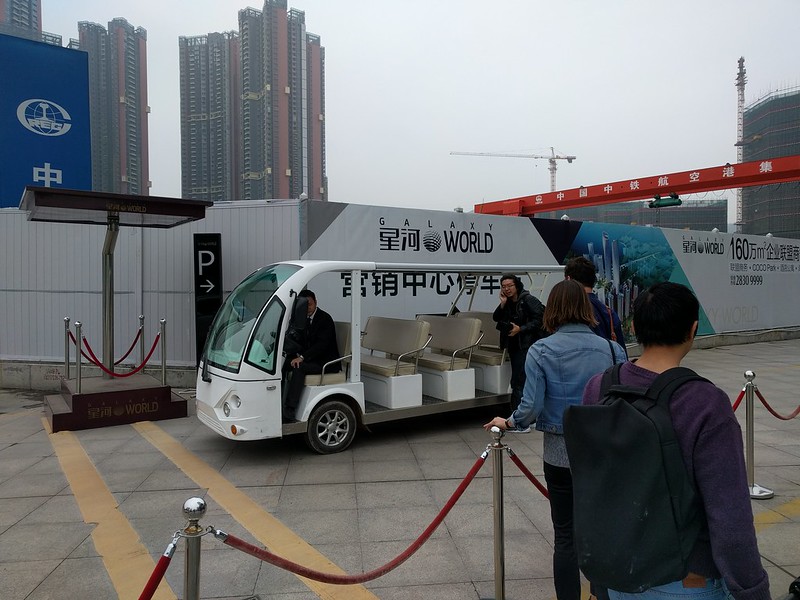 Our pickup shuttle. This is how we get to our meeting in a golf resort in the mountains.
Our pickup shuttle. This is how we get to our meeting in a golf resort in the mountains.
Before we know it, we find ourselves on a golf cart to the next meeting. World Maker Group (WMG), a product realization platform, is based in a former (never fully opened) golf resort, now part of real estate developer Galaxy’s innovation and incubation space. Our kind host is WMG’s CEO Yang Yang.
Everybody on this trip has been incredibly generous with their time.
///
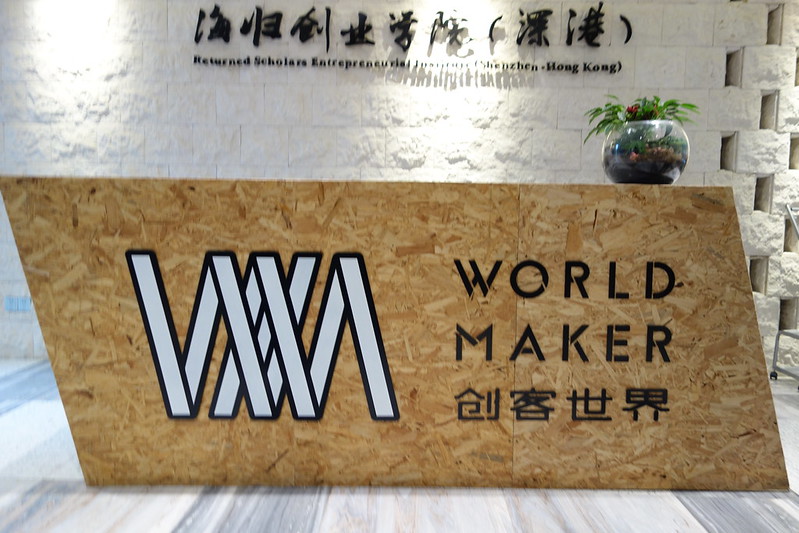 World Maker Group headquarters
World Maker Group headquarters
The word “maker” has a slightly different connotation in China. Just like in the West it is slightly confusing, but in China it isn’t used quite as exclusively for hobbyists. Shenzhen focuses on the hardware making aspect of the term as that is a long tradition here.
WMG mostly does client work, but increasingly look into own in house products: In that way it’s like many Western agencies, too. We see early prototypes, but promise not to share those.
///
If someone has a promising, futuristic idea, they might have to convince manufacturers to take a risk on this new idea, especially if they are looking at really small production runs.
One example we learn about is Disrupt Surfing, an Australian startup. They make custom-designed surf boards. In a venture like that, initial runs might be just in the dozens. It’s very low quantity, but potentially large margin in the future. Just like in Europe this might be a hard sell, you got to find the right partner.
///
Some things we see throughout the day:
Lots of medical devices and care devices. Crutches, medical beds, a portable computer for remote diagnosis and video conferencing with the doctor.
A contact mic speaker for 65rmb (under 10 Euros). No connection needed, just put the phone on top. A great example of the Chinese “micro innovation” people keep telling us about.
A medical tablet has a physical blocker for the camera. This makes the privacy level easy to read, very secure. The video camera can be disabled by moving a physical shutter across it.
///
Everything runs Android. Everything.
///
Shenzhen designers/companies know manufacturing in all its facets, but tend to have deficits in branding and figuring out market fit, compared to their US counterparts. Many US and European companies and designers have great vision, branding, and market fit, but have deficits in manufacturing.
Our host Yang Yang himself has a background from the UK and ThyssenKrupp, hence can translate well between cultures.
This is a recurring theme: Everyone we meet and has leadership group has studied abroad or worked abroad. They’re all not just experts but translators between cultures, too.
Manufacturers locally aren’t necessarily strong in design and branding. WMG helps.
Yang Yang’s founding partners have strong connections to Foxconn. Through established, trusted connections it’s possible to convince Foxconn to take smaller production runs as well, to fill up surplus manufacturing capacity. Yet another example of how business is done here through connections. If you parachute in, there’s no way of getting this type of access. (This might be true everywhere.)
///
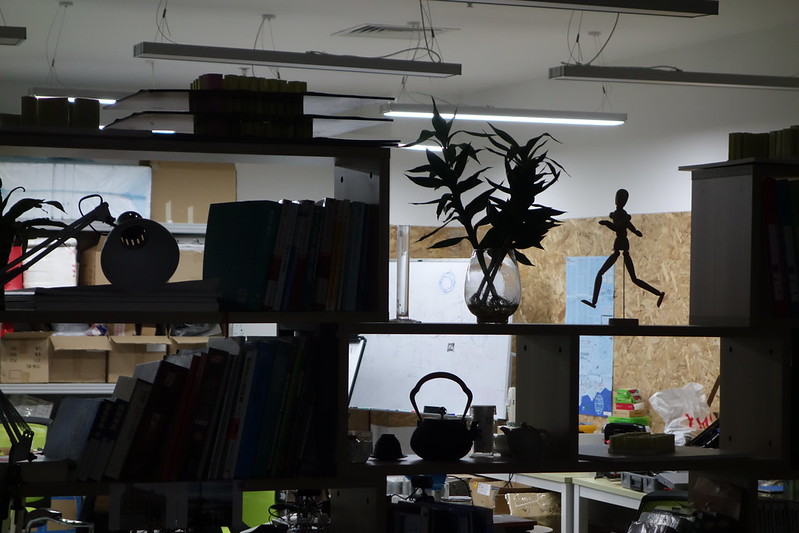 Creative spaces have the same pleasant vibe all over the globe.
Creative spaces have the same pleasant vibe all over the globe.
WMG works full scale from makers to universities to startups to client work. They are also involved with an international incubator exchange with universities in Europe and beyond.
We see some slides and schematics about the product realization workflow. It is crazy complex.
///
///
Government funding is available to boost innovation. There is no restriction of what’s funded, it just depends on who’s pitching. You need to be a maker, but of course that definition is hard to pin down.
This type of funding by the Shenzhen government is relatively slow for Shenzhen standards, maybe 6 months until money is in the bank, and has to go through a local registered, government recognized organization (like WMG). But it comes with no formal strings attached. Follow-up funding usually is available.
If needed, clients can send an engineer to work onsite, or WGM engineers can work onsite at the client’s HQ. Yang relays a story of sending out an engineer to solve a tricky injection challenge the partner to has been struggling with for a month: Because he knows this craft inside out he solves it overnight.
WMG is fully integrated, full stack. from design and manufacturing up to and including Android and iOS dev where needed.
///
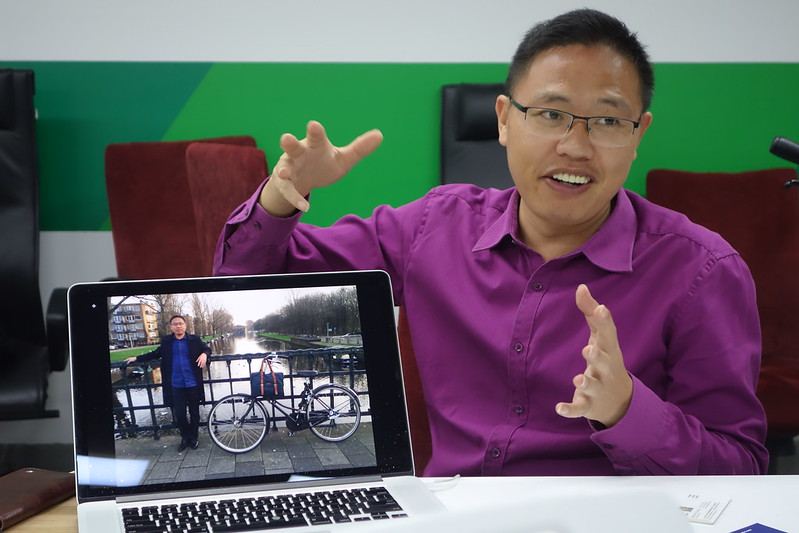 Kevin Zhang of WMG shares his experiences with Amsterdam bike sharing systems
Kevin Zhang of WMG shares his experiences with Amsterdam bike sharing systems
We learn about bike sharing in China. This of course is highly relevant to the bike project we brought to Shenzhen.
Some stats (proceed with care, I took notes on the fly):
- Mobike: about USD 150 to make, signup (deposit) is about USD 50. So 3 registered users pay for 1 bike. After that it’s almost 100 percent profit. The bikes are made to be extremely robust: aluminum frame, solid tires etc.
- Usage: 20% professional bike users (as in “use it for their job”), say as couriers. 20% are mountain bikers. The other 60% of bike riders don’t care about bike looks, just about use and having access to bikes. They are the ones who use locks, too. (The first two groups don’t use locks, they store their bikes elsewhere.)
- Didi/Uber car sharing is hugely popular.
- Substitute drivers are a big thing: A driver who’d drive you home with your car, then takes a ride back home. This is due to rigid laws against drunk driving.
- Private bus services in addition to public buses. Tencent has 35 lines in Shenzhen alone.
- Public bike sharing since 2010. Centralized. Then one iteration (private? gov-run?). Since 2014 there’s mobike, ofo.so, qibei, and other new generation of decentralized smart bike sharing. Locks are important on these decentralized ones.
- mobike: 299 RMB for sign-up, 1 Yuan per 30min. Others: 20p sign up, first hour free, then charge (our camera man interjects: “The sensors are really bad!”).
- ofo: 99 RMB for signup, 2 Yuan cap inside university campus, different cap outside.
- mobike 0.08 percent of population reached. Sounds like not a whole lot, but that happened within 3 months of launch. But this is China, so we’re talking about 80m people. It’s a crazy steep growth curve.
///
The reactions to our bike project are always great: in this case a loud, bursting belly laugh. A decentralized, crypto-currency based, autonomous bike rental scheme? Sure, why not!
///
The margin for companies like WMG isn’t in design. It’s in manufacturing at scale. Here it’s all about the hardware. This makes for a very straight-forward business model.
///
 The former driving range is now used for drone flying
The former driving range is now used for drone flying
Behind the WMG HQ there’s a park: This would have been the golf court’s driving range, had it ever opened. Now it’s used mainly for relaxing and for flying drones. Among the many companies also housed in the incubation and coworking space in the complex is a drone flying academy.
///
 Golf cart number 2 is how we get back to the cab: The black-and-gold cart feels like we leveled up once more.
Golf cart number 2 is how we get back to the cab: The black-and-gold cart feels like we leveled up once more.
///
In the evening, we reflect and record final wrap up interviews with the team.
Our final team dinner takes us to a 17-year old western-movie-themed Szechuan restaurant. 17 years is old in Shenzhen, after all the city is only 36 years old. On the wall, in between black and white photos of movie stars, a painting of Beethoven.
///
I learn there’s a massive train construction project under way to build a China-Germany high speed train connection.
///
Today concludes our trip. Team Incredible Machine will stay for another day to do a last round of interviews and conduct some market business, but tomorrow Michelle and I will be off to Hong Kong to fly back home.
We got a lot to process, many impressions to let sink in. I learned a lot; we all did. I’ll have some writing to do.
///
We go sing karaoke till late. There are lots of karaoke places to choose from. We’re one of many groups that night, but the only non-Chinese one.
